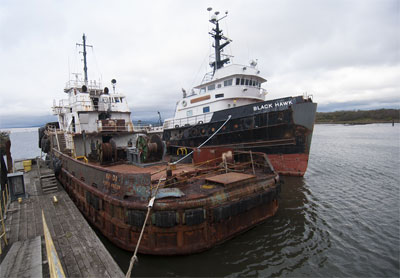There are different models of fleet building among tug companies. They vary according to the firm’s principal areas of operation, but they will vary within categories as well. Sause Bros. Inc., based in Coos Bay, Ore., with boats stationed in Hawaii, Los Angeles and Portland, continues to build a fleet based on the consideration of a wide range of performance factors.
Recently, company president Dale Sause took some time to explain his company’s strategy. “It isn’t any one thing that makes a tug and barge efficient,” he explained. “It is a total of a lot of small things.”
With a fleet of 55 tugs and barges, and others being built or purchased, there are a lot of variables to be calculated. In addition to three crew boats serving the Los Angeles oil islands, they have six L.A.-based tugs, seven Honolulu tugs and 17 tugs based in Coos Bay. It is a collection of vessels that Sause and his team take pride in having put together. Growing up around the business when his dad and uncles ran it, Sause learned to respect a good tug.
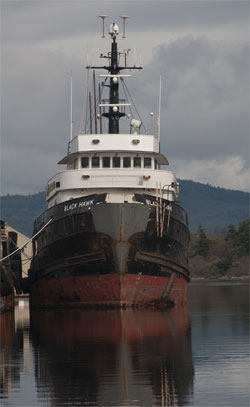 |
|
Black Hawk will get a pair of MTU 12-cylinder 1,740-hp engines with Reintjes gears. |
When his uncle had a heart attack, his dad told him to finish up his degree at the University of Washington and get back to working with the company. That was in the mid-70s and the majority of vessels in the company fleet were still single screw.
They worked primarily towing lumber scows to California from Canada, Washington and Oregon. They were doing a little towing to Hawaii, but when the lumber business declined, they grew the Hawaii business.
Sause had taken some engineering courses and understood the importance of computational fluid dynamics (CFD) in marine design. In 2006 he spent a week in Sweden for tank testing of hydralift skegs on a new barge design with the late Josip Gruzling of Nautican Research & Development Ltd., in North Vancouver. Together with Sause’s own engineers, first Jack Wilskey and later Mark Babcock, and the naval architectural firm Hockema and Whalen, the company continues its quest for improved fluid dynamics. This is true for both barges and tugs.
Sause Bros. has its new barges built at Gunderson Marine in Portland. Computer generated profiles show any turbulence that builds around the bow and stern. The computer allows this to be modeled at various speeds. The design is then tuned to reduce the turbulence. “A barge shaped like a shoe box has a prismatic of 100 percent. As you carve away pieces of the bow and the stern this is reduced,” Sause explained.
“The finer the lines the lower the prismatic. A typical 1970s barge with a rake on the bow and a cube body had a .88 to .89 prismatic.”
Of particular significance to the improved prismatic of the company’s barges is the use of Nautican’s hydralift skegs mounted under the stern counter. So a carefully contoured bow allows good water flow under and around the barge, while the right taper aft allows the water to flow over the horizontal foil of the skegs and to run cleanly away from the barge without the tumbling cavitations typical of flat-transomed barges.
The company has about 25 barges. They include a 426-by-105-by-25-foot container barge for the Portland to Hawaii route and a number of 380-by-76-by-31-foot Bay-class double-hulled oil barges. Souse Bros. currently has its 10th barge building with Gunderson. These latter have been determined to be an optimum size for towing along the Pacific coast. “By refining the bow and stern, we have been able to bring the prismatic of these 380-foot Bay-class barges down to .76,” Sause said.
While work continues to study bow waves and turbulence, the company is paying attention to early research on air injection under barge bottoms that will further reduce the prismatic. Computer screens in Sause’s office display turbulence around the hull of the existing barge designs at various speeds.
Other methods of decreasing drag are also being implemented. When the company launched the tug Mikiona at J.M. Martinac Shipbuilding in 2007, it was fitted with a Rapp Hydema towing winch. The winch has an “auto trawl” option developed for commercial fishing trawlers to maintain a steady pull on the net warps. On the tug it acts like the constant-tension option on a docking tug’s hawser winch. On a towing winch, it allows the captain to dial in a towing load so that when working in seas, the winch will allow a little line to pay out and then recover with the surge.
A Sause tug might work these surges with 1,800 feet of the 2,400 feet of two-inch wire that most carry. The wire hangs well down between the tug and tow to act as a surge or shock absorber. The trawl feature will allow that to be shortened up to as little as 400 feet. In so doing, a lot of drag is taken out, resulting in improved towing efficiency, which equals improved speed or fuel consumption.
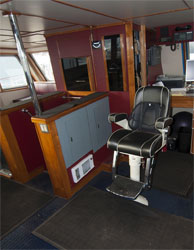 |
|
The barber’s chair in Black Hawk’s wheelhouse would be a source of pride for any tug crew. |
The Sause investment model tends toward new barges and refurbished tugs — although refurbished might be an understatement for some of the work that they have done.
In November 2012 the Sause tug Tecumseh (ex El Gato Grande) was on its first tow since an extensive rebuild. Purchased from Tidewater in 2006, the 116-by-34-foot tug was built by American Gulf Shipbuilding in 1979. Sause rebuilt the MAN B&W 12V23L medium-speed engines that each generate 1,740 hp at 800 rpm. The engines turned controllable-pitch (CP) propellers in Kort 19A nozzles. These have been replaced with high-speed nozzles and new prop blades.
“Computational fluid dynamics showed us that this change would increase the efficiency by 22 percent. With the CP props, it was an easy job as we kept the same hub and just bolted on the new blades,” said Sause. “This boat is now matched with the 360-foot double-hulled oil barge Drakes Bay.”
On the tug’s deck, a new Markey towing winch was installed along with new hydraulic tow pins fabricated in Sause Bros.’ own shipyard. As with all Sause tugs, special attention is given to comfort, especially sound dampening, in the accommodations. Noting that a well-rested crew is a safe crew, Sause said, “Studies have shown dramatic effects on rest from engine noises. It is to our benefit to have well-rested crews.”
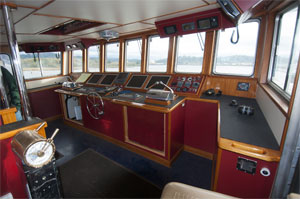 |
|
Carpenters built Black Hawk’s wheelhouse to a very high standard of workmanship. The galley and accommodation areas are getting similar treatment. |
In November 2012, there were two more tugs alongside at the Sause headquarters in Coos Bay. Both were being refurbished as time permitted. The 127.7-by-34.8-foot Nakoa (ex Gulf Runner) was built in 1975 by Service Machinery and Shipbuilding. Sause will repower it with a pair of 16-cylinder 4000 Series MTU engines each producing 2,750 hp at 1,800 rpm. With this power the boat will be well suited for towing the larger 426-by-105-foot container barge on the Hawaii route.
Also at the Coos Bay dock and moored just outside Nakoa, the tug Black Hawk was also awaiting new engines. Built in 1968 by Halter Marine and purchased by Crowley Maritime, the heavily built boat is of particular interest to Sause. “It has a round chine that no one makes today, as the cost is prohibitive. Today’s boats are single or double chined. Because of her rounded bottom, the Black Hawk has a prismatic of only .68.”
A previous owner had begun to refurbish Black Hawk with a beautiful upgrade of the wheelhouse, including some very fine wood joinery done at Point Hope Maritime in Victoria, British Columbia. The accommodation area includes eight separate staterooms for the crew. These have been redone with equal quality. Sause shore crews have stripped all the appliances and counters from the galley and mess area and are currently redoing it to the level of the upper decks. This will be a very comfortable boat.
On the aft deck, a set of hydraulic tow pins of Sause’s own design have been installed, and the whole deck area, including the covered area aft of the main house, has been sandblasted and will be painted. Extensive steel has been replaced on the bulwarks, as well as on the bow where new fendering will be installed. A massive Burrard Iron Works winch has been overhauled and was protected from the sandblasting with plywood sheeting. “When this boat first came out with that winch, our guys would have marveled at its power and quality,” explained Sause. “It doesn’t have the modern controls of the Rapp Hydema, but these are very good winches.”
The most significant change for Black Hawk will be a repower. The existing EMD engines will be replaced by a new set of 12-cylinder MTU engines each developing 1,740 hp at 1,800 rpm and coupled to Reintjes gears. When complete next July, Black Hawk will be paired with one of the 360-by-105-foot Bay-class barges, and can fill in on the Hawaii run. Black Hawk will also receive three new auxiliaries.
Speaking of the quite different work being done on Nakoa and Black Hawk, Sause said, “Our model tends to be more long term with regard to cost recovery, although to repower and refurbish the Black Hawk will cost about $4 million. To build a new tug of this size with a double-chine hull would cost about $12 million. To build a tug with this rounded-chine hull would cost more like $15 million.”
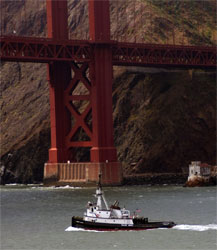 |
|
The Sause tug Joseph Sause approaches the Golden Gate Bridge. |
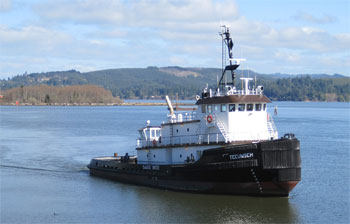 |
|
Tecumseh in 2012 after its MAN B&W 12V23L engines were rebuilt and the blades replaced on its CP propeller. |
Sause added that the operational model for the tugs is equally important if they are to be profitable. “We generally operate at 72 to 82 percent of our available power range except in a weather emergency,” he explained. “We optimize fuel and engine life with speed over the ground for best fuel consumption at the best speed for a timed arrival. You don’t rush to arrive before there are shore crews available. The captain uses an onboard computer program to set parameters. Our dispatch has the same program and can counsel the captain. Whenever we suggest a change from the office, it is always prefaced with ‘If you can do it safely.’ The captain is the final arbitrator of that.”
“There are situations where, even with good weather, the questions is asked, ‘Is it worth burning an extra 6,000 gallons of fuel over 48 to 72 hours to make a deadline?’ But this becomes a marketing decision. In 1999 our port engineer, the late Jack Wilskey, predicted fuel would reach a dollar per gallon and encouraged the building of hydrodynamic-efficient equipment,” Sause explained. “Now fuel is much higher and EPA air emissions have been a driver that we have had to pay for with fuel efficiency.”
The fuel burn versus engine hours is an issue that gets attention at Sause Bros. “We visited many of the major engine manufacturers’ plants,” Sause explained. “We’ve been doing life-cycle modeling for 10 years now. We wanted to see for ourselves how they reached their time-between-overhaul (TBO) estimates. While quality was high at a number of factories, we were most impressed with the European standards of MTU. Each part of the engine has some measure of TBO.”
That is not to say that there are no failures in equipment at Sause, but when a failure does occur, it is analyzed for cause. Recently the company had a failure in a high-pressure fuel pump. It was nearing time for its scheduled overhaul, but investigation showed that when California introduced its requirements for ultra-low sulfur fuels, not all fuel producers put in enough additive to make up for the lack of lubricity.
“We now test more of our fuel, even though additives have improved,” Sause said as one more example of the detailed attention that has led this second-generation family company to continued success in a challenging and competitive world.

